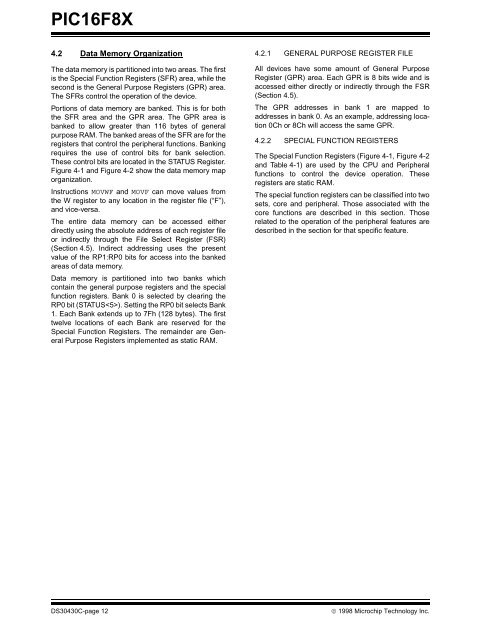PIC16F8X, 18-Pin FLASH/EEPROM 8-Bit MCU Data Sheet - Microchip
PIC16F8X, 18-Pin FLASH/EEPROM 8-Bit MCU Data Sheet - Microchip
PIC16F8X, 18-Pin FLASH/EEPROM 8-Bit MCU Data Sheet - Microchip
Create successful ePaper yourself
Turn your PDF publications into a flip-book with our unique Google optimized e-Paper software.
<strong>PIC16F8X</strong><br />
4.2 <strong>Data</strong> Memory Organization<br />
The data memory is partitioned into two areas. The first<br />
is the Special Function Registers (SFR) area, while the<br />
second is the General Purpose Registers (GPR) area.<br />
The SFRs control the operation of the device.<br />
Portions of data memory are banked. This is for both<br />
the SFR area and the GPR area. The GPR area is<br />
banked to allow greater than 116 bytes of general<br />
purpose RAM. The banked areas of the SFR are for the<br />
registers that control the peripheral functions. Banking<br />
requires the use of control bits for bank selection.<br />
These control bits are located in the STATUS Register.<br />
Figure 4-1 and Figure 4-2 show the data memory map<br />
organization.<br />
Instructions MOVWF and MOVF can move values from<br />
the W register to any location in the register file (“F”),<br />
and vice-versa.<br />
The entire data memory can be accessed either<br />
directly using the absolute address of each register file<br />
or indirectly through the File Select Register (FSR)<br />
(Section 4.5). Indirect addressing uses the present<br />
value of the RP1:RP0 bits for access into the banked<br />
areas of data memory.<br />
<strong>Data</strong> memory is partitioned into two banks which<br />
contain the general purpose registers and the special<br />
function registers. Bank 0 is selected by clearing the<br />
RP0 bit (STATUS). Setting the RP0 bit selects Bank<br />
1. Each Bank extends up to 7Fh (128 bytes). The first<br />
twelve locations of each Bank are reserved for the<br />
Special Function Registers. The remainder are General<br />
Purpose Registers implemented as static RAM.<br />
4.2.1 GENERAL PURPOSE REGISTER FILE<br />
All devices have some amount of General Purpose<br />
Register (GPR) area. Each GPR is 8 bits wide and is<br />
accessed either directly or indirectly through the FSR<br />
(Section 4.5).<br />
The GPR addresses in bank 1 are mapped to<br />
addresses in bank 0. As an example, addressing location<br />
0Ch or 8Ch will access the same GPR.<br />
4.2.2 SPECIAL FUNCTION REGISTERS<br />
The Special Function Registers (Figure 4-1, Figure 4-2<br />
and Table 4-1) are used by the CPU and Peripheral<br />
functions to control the device operation. These<br />
registers are static RAM.<br />
The special function registers can be classified into two<br />
sets, core and peripheral. Those associated with the<br />
core functions are described in this section. Those<br />
related to the operation of the peripheral features are<br />
described in the section for that specific feature.<br />
DS30430C-page 12 © 1998 <strong>Microchip</strong> Technology Inc.

















